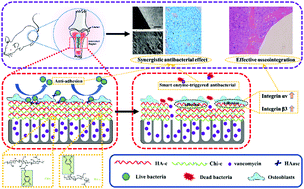Surface engineering of titanium implants with enzyme-triggered antibacterial properties and enhanced osseointegration in vivo†
Abstract
Preventing bacterial infection and improving the osseointegration of titanium (Ti) and its alloys are both highly crucial factors for their long-term successful implantation in clinical applications. However, the straightforward applications of antibacterial surfaces on Ti-based materials remain limited due to their side effects on cytocompatibility. Herein, catechol-functionalized multilayer films composed of dopamine-modified hyaluronic acid (HA-c) and 3,4-dihydroxyhydrocinnamic acid-modified chitosan (Chi-c) were developed on Ti substrates modified with TiO2 nanotube arrays loaded with an antibacterial drug. The treated Ti substrate showed strong hydrophilicity, with a water contact angle of about 20°, and obviously inhibited early-stage bacterial adhesion. Moreover, this system displayed an enzyme-responsive release of antibacterial drug triggered by the hyaluronidase degradation of HA-c, which exhibited effective antibacterial ability and eliminated side effects caused by burst release of antibiotics. Meanwhile, the modified Ti substrates significantly promoted initial osteoblast adhesion through up-regulating the expression of adhesion-related genes, including integrin αv and β3. More importantly, this prepared coating with bacterial self-responsiveness improved osseointegration and prevented bacterial infection of Ti implants in vivo. Overall, our developed catechol-functionalized and bacterial self-responsive coating on Ti substrate has great significance in clinical applications of orthopedic and dental implants.



 Please wait while we load your content...
Please wait while we load your content...